

Chin J Plant Ecol ›› 2024, Vol. 48 ›› Issue (10): 1256-1273.DOI: 10.17521/cjpe.2023.0076 cstr: 32100.14.cjpe.2023.0076
• Research Articles • Previous Articles Next Articles
HUANG Li-Cheng1,2, MO Xing-Guo1,2,3,*( )
)
Received:2023-03-16
Accepted:2024-01-16
Online:2024-10-20
Published:2024-12-03
Contact:
MO Xing-Guo
Supported by:HUANG Li-Cheng, MO Xing-Guo. Response and resilience of net primary productivity of the Hai River Basin ecosystems under meteorological droughts[J]. Chin J Plant Ecol, 2024, 48(10): 1256-1273.
Add to citation manager EndNote|Ris|BibTeX
URL: https://www.plant-ecology.com/EN/10.17521/cjpe.2023.0076

Fig. 1 Distribution of natural vegetation in the Hai River Basin (based on International Geosphere-Biosphere Programme (IGBP) land cover classification system with spatial resolution of 500 m). CS, closed shrubland; DBF, deciduous broadleaf forest; DEMF, deciduous-evergreen mixed forest; GL, grassland; HRB, the Hai River Basin; SVN, savanna; WSVN, woody savanna.
| 数据产品 Data product | 数据项 Data item | 时间分辨率 Temporal resolution | 空间分辨率 Spatial resolution | 数据来源 Data source |
|---|---|---|---|---|
| 中国区域地面 气象要素驱动 数据集 China Meteorological Forcing Dataset (CMFD) | 月均气温 Monthly average air temperature | 1自然月 1 sequential month | 0.1° | 国家青藏高原 科学数据中心 National Tibetan Plateau Scientific Data Center ( |
| 月降水 Monthly precipitation | ||||
| 太阳辐射量 Solar radiation | ||||
| 近地面风速 Near-surface wind speed | ||||
| 近地面气压 Near-surface air pressure | ||||
| 近地面比湿 Near-surface specific humidity | ||||
| 实际蒸散量 Evapotranspiration (ET) | 1自然月 1 sequential month | 1 km | 植被界面过程(VIP)模型 Vegetation Interface Process (VIP) model | |
| MOD13A1.061 | NDVI | 16 d | 500 m | Google Earth Engine ( |
| MOD17A2.006 | 总初级生产力 Gross primary productivity (GPP) | 8 d | 500 m | |
| MCD12Q1.006 | 土地覆被类型 Land cover type | 1 a | 500 m | |
Table 1 Vegetation and climate data and its sources of the Hai River Basin
| 数据产品 Data product | 数据项 Data item | 时间分辨率 Temporal resolution | 空间分辨率 Spatial resolution | 数据来源 Data source |
|---|---|---|---|---|
| 中国区域地面 气象要素驱动 数据集 China Meteorological Forcing Dataset (CMFD) | 月均气温 Monthly average air temperature | 1自然月 1 sequential month | 0.1° | 国家青藏高原 科学数据中心 National Tibetan Plateau Scientific Data Center ( |
| 月降水 Monthly precipitation | ||||
| 太阳辐射量 Solar radiation | ||||
| 近地面风速 Near-surface wind speed | ||||
| 近地面气压 Near-surface air pressure | ||||
| 近地面比湿 Near-surface specific humidity | ||||
| 实际蒸散量 Evapotranspiration (ET) | 1自然月 1 sequential month | 1 km | 植被界面过程(VIP)模型 Vegetation Interface Process (VIP) model | |
| MOD13A1.061 | NDVI | 16 d | 500 m | Google Earth Engine ( |
| MOD17A2.006 | 总初级生产力 Gross primary productivity (GPP) | 8 d | 500 m | |
| MCD12Q1.006 | 土地覆被类型 Land cover type | 1 a | 500 m | |
| 土地覆被类型 Land cover type | εmax (g·MJ-1) | NDVImax | 样本量 Pixels of vegetations |
|---|---|---|---|
| 落叶阔叶林 Deciduous broadleaf forest | 0.692 | 0.862 | 8 912 |
| 落叶-常绿混交林 Deciduous-evergreen mixed forest | 0.768 | 0.839 | 1 278 |
| 郁闭灌丛 Closed shrubland | 0.429 | 0.831 | 2 314 |
| 多树草原 Woody savanna | 0.542 | 0.811 | 1 754 |
| 稀树草原 Savanna | 0.542 | 0.806 | 10 030 |
| 草原 Grassland | 0.542 | 0.645 | 121 070 |
Table 2 Maximum light use efficiency (εmax) and maximum normalized differential vegetation index (NDVImax) of natural ecosystems in the Hai River Basin
| 土地覆被类型 Land cover type | εmax (g·MJ-1) | NDVImax | 样本量 Pixels of vegetations |
|---|---|---|---|
| 落叶阔叶林 Deciduous broadleaf forest | 0.692 | 0.862 | 8 912 |
| 落叶-常绿混交林 Deciduous-evergreen mixed forest | 0.768 | 0.839 | 1 278 |
| 郁闭灌丛 Closed shrubland | 0.429 | 0.831 | 2 314 |
| 多树草原 Woody savanna | 0.542 | 0.811 | 1 754 |
| 稀树草原 Savanna | 0.542 | 0.806 | 10 030 |
| 草原 Grassland | 0.542 | 0.645 | 121 070 |
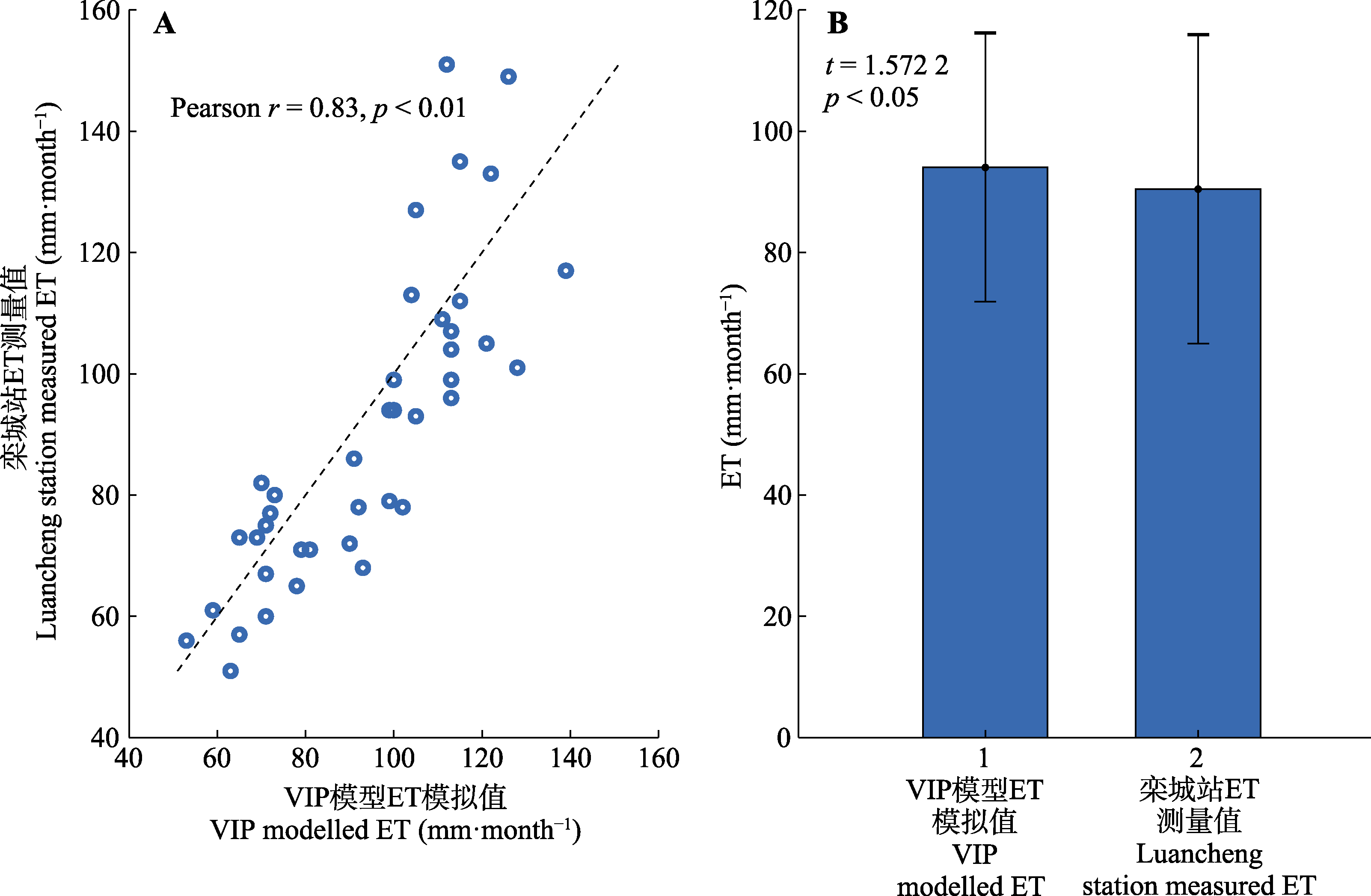
Fig. 2 Correlation coefficient (A) and t-test result (B) between Vegetation Interface Process (VIP) modelled evapotranspiration (ET) and ET measured in Luancheng station (mean ± 22.14/25.50).
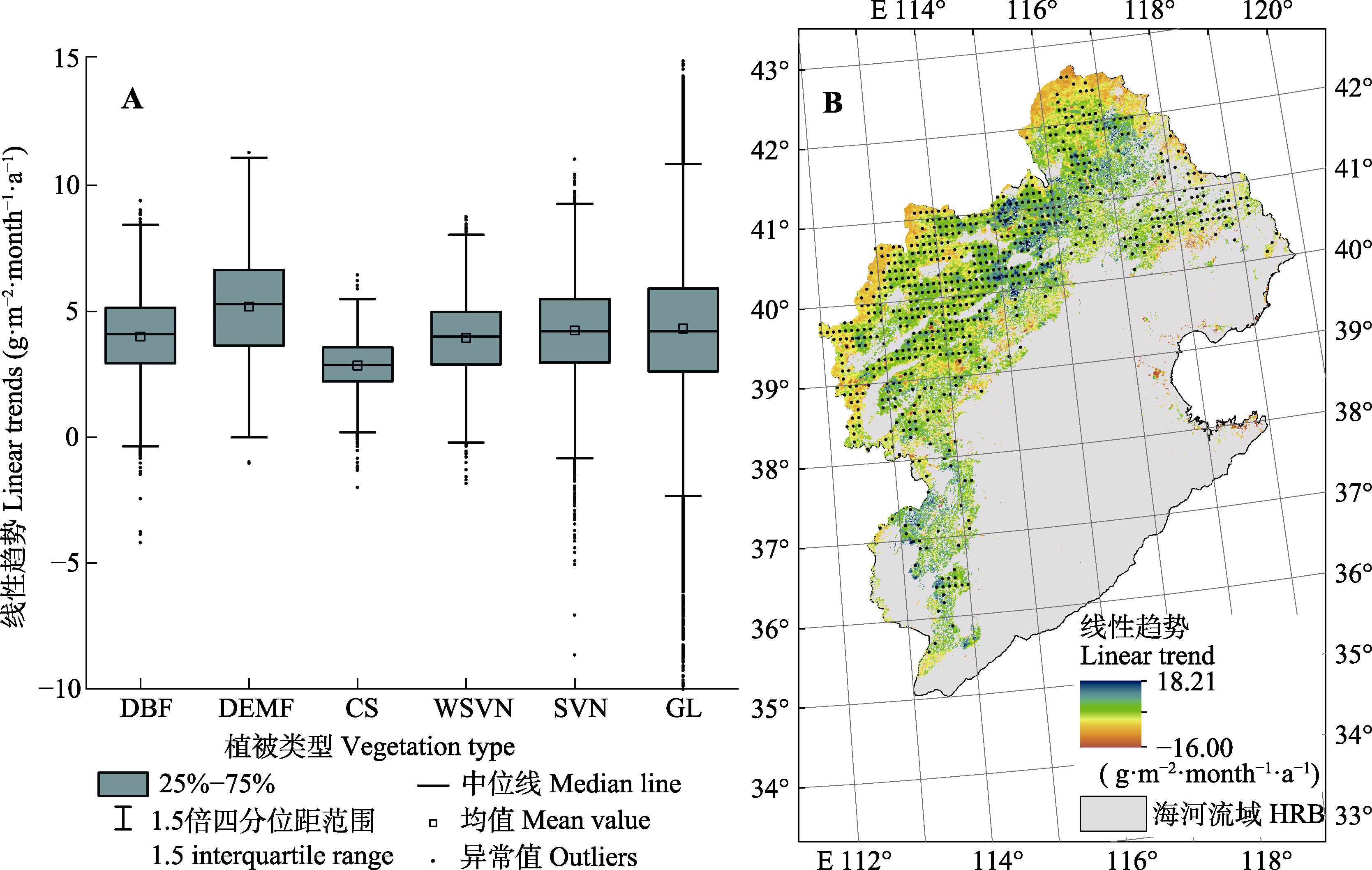
Fig. 4 Trends of natural vegetation net primary productivity (NPP) changes (A) and spatial distribution of linear trends of natural vegetation NPP changes (B) in the Hai River Basin. CS, closed shrubland; DBF, deciduous broadleaf forest; DEMF, deciduous-evergreen mixed forest; GL, grassland; HRB, the Hai River Basin; SVN, savanna; WSVN, woody savanna. Each black dot in B indicates samples within the 0.1° × 0.1° grid are with significant monotonic tendency confirmed through Mann-Kendall method, with average p < 0.05.
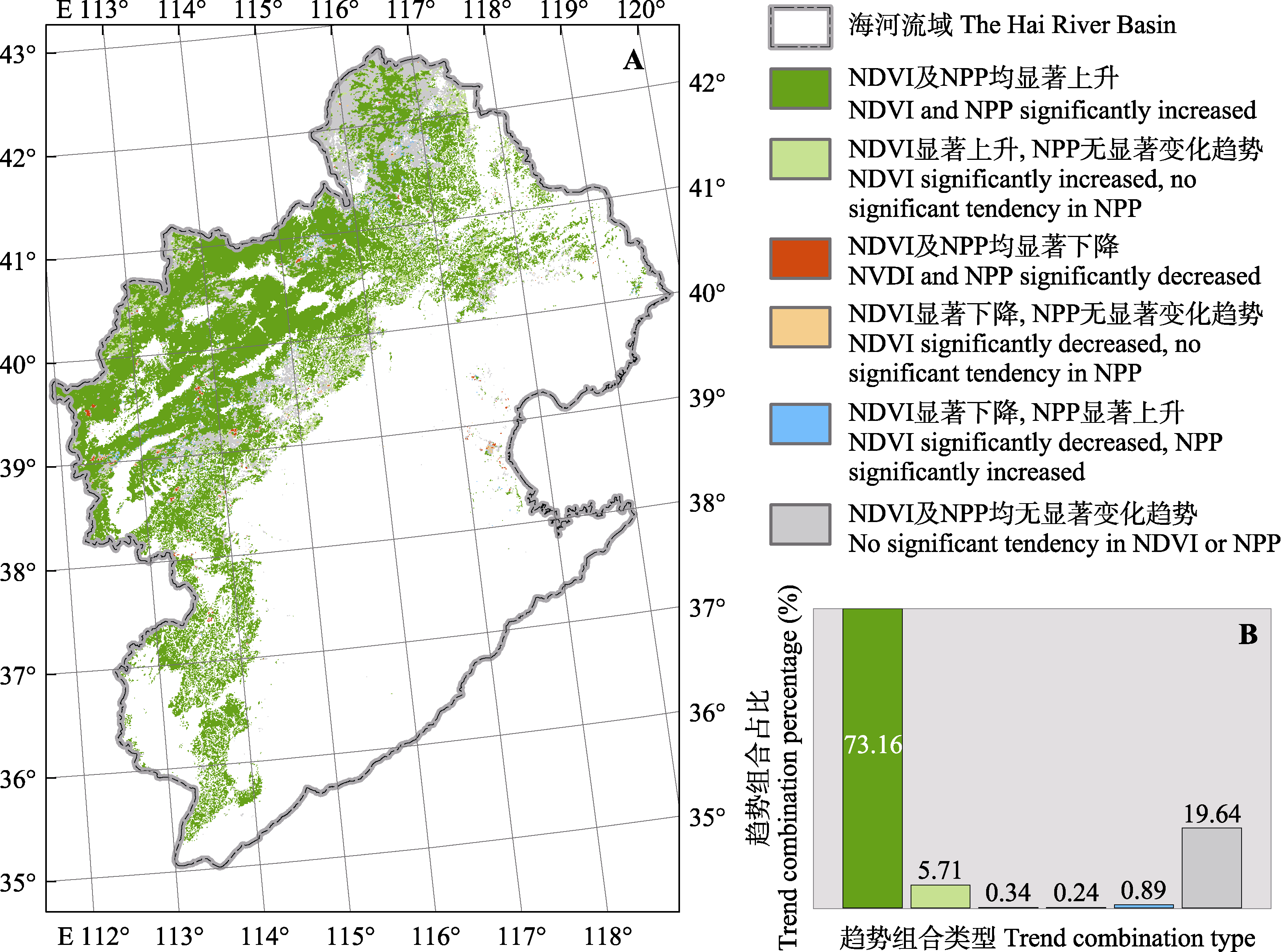
Fig. 5 Spatial distribution of Mann-Kendall test results of natural vegetation net primary productivity (NPP) and normalized differential vegetation index (NDVI) changes in the Hai River Basin (A) and quantitative distribution of the Mann-Kendall test results (B).
| 分布参数 Distribution parameter | 落叶阔叶林 Deciduous broadleaf forest | 落叶-常绿混交林 Deciduous-evergreen mixed forest | 郁闭灌丛 Closed shrubland | 多树草原 Woody savanna | 稀树草原 Savanna | 草原 Grassland |
|---|---|---|---|---|---|---|
| 标准差 Standard deviation (g·m-2·month-1) | 42.18 | 46.67 | 27.15 | 37.51 | 35.66 | 38.12 |
| 选定样本数量比 Quantitative proportion of the chosen samples (%) | 25.16 | 25.09 | 29.03 | 26.67 | 25.33 | 23.63 |
| 选定样本质量比 Qualitative proportion of the chosen samples (%) | 60.54 | 59.70 | 61.97 | 59.82 | 58.54 | 56.67 |
Table 3 Distribution of natural vegetation net primary productivity changes (ΔNPP) in the Hai River Basin
| 分布参数 Distribution parameter | 落叶阔叶林 Deciduous broadleaf forest | 落叶-常绿混交林 Deciduous-evergreen mixed forest | 郁闭灌丛 Closed shrubland | 多树草原 Woody savanna | 稀树草原 Savanna | 草原 Grassland |
|---|---|---|---|---|---|---|
| 标准差 Standard deviation (g·m-2·month-1) | 42.18 | 46.67 | 27.15 | 37.51 | 35.66 | 38.12 |
| 选定样本数量比 Quantitative proportion of the chosen samples (%) | 25.16 | 25.09 | 29.03 | 26.67 | 25.33 | 23.63 |
| 选定样本质量比 Qualitative proportion of the chosen samples (%) | 60.54 | 59.70 | 61.97 | 59.82 | 58.54 | 56.67 |

Fig. 6 Distribution of Spearman rank correlation coefficient (ρ) between net primary productivity changes (ΔNPP) and standardized precipitation evapotranspiration index (SPEI) in the Hai River Basin along SPEI time scales. A, Deciduous broadleaf forest. B, Deciduous-evergreen mixed forest. C, Closed shrubland. D, Woody savanna. E, Savanna. F, Grassland.
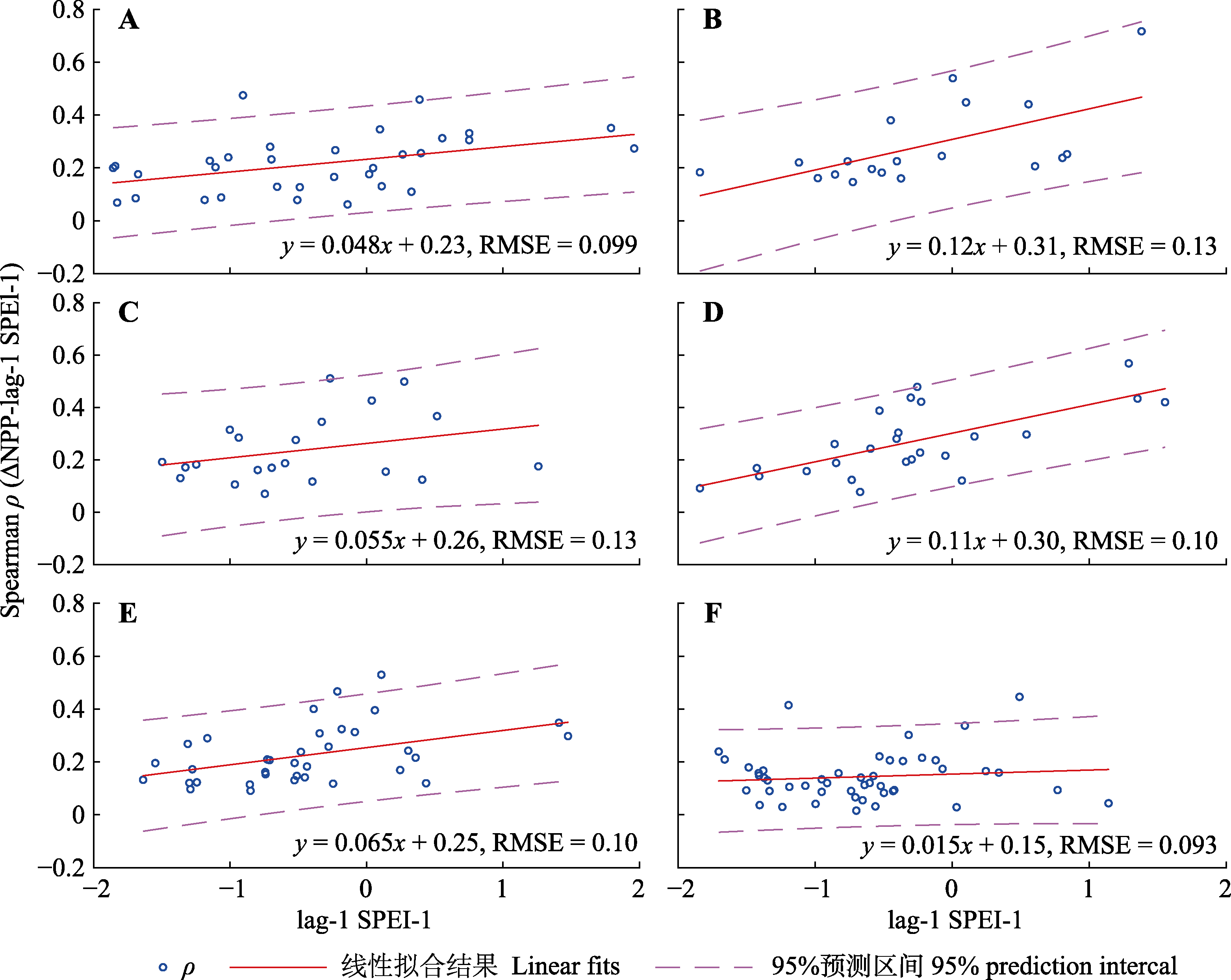
Fig. 7 Linear fit of net primary productivity changes (ΔNPP) to standardized precipitation evapotranspiration index (SPEI) Spearman rank correlation coefficient (ρ) and average lag-1 SPEI-1 of the corresponding vegetation types in the Hai River Basin. A, Deciduous broadleaf forest. B, Deciduous-evergreen mixed forest. C, Closed shrubland. D, Woody savanna. E, Savanna. F, Grassland. RMSE, root mean square error.
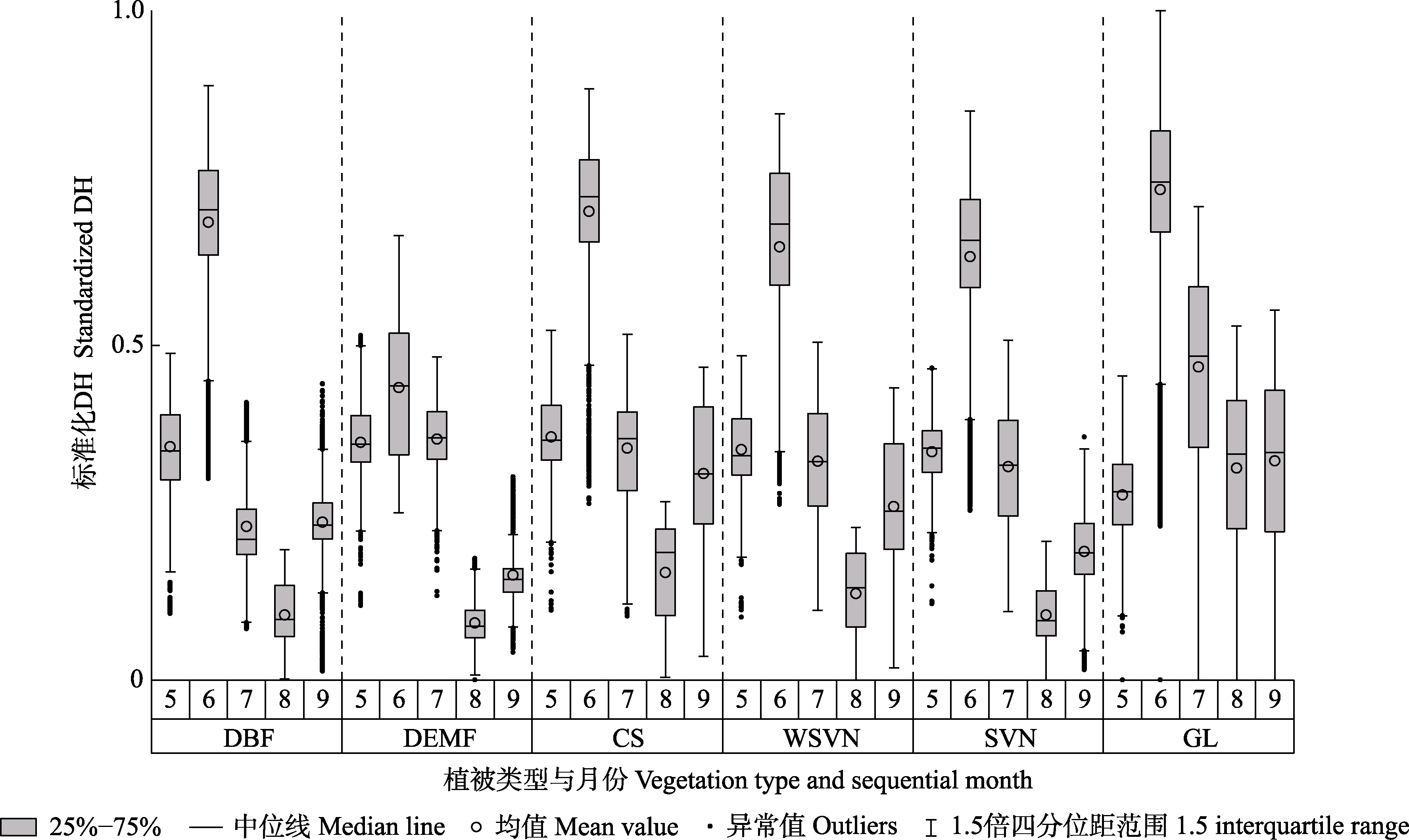
Fig. 8 Distribution of standardized drought hazard (DH) in the Hai River Basin, listed by vegetation type. CS, closed shrubland; DBF, deciduous broadleaf forest; DEMF, deciduous-evergreen mixed forest; GL, grassland; SVN, savanna; WSVN, woody savanna
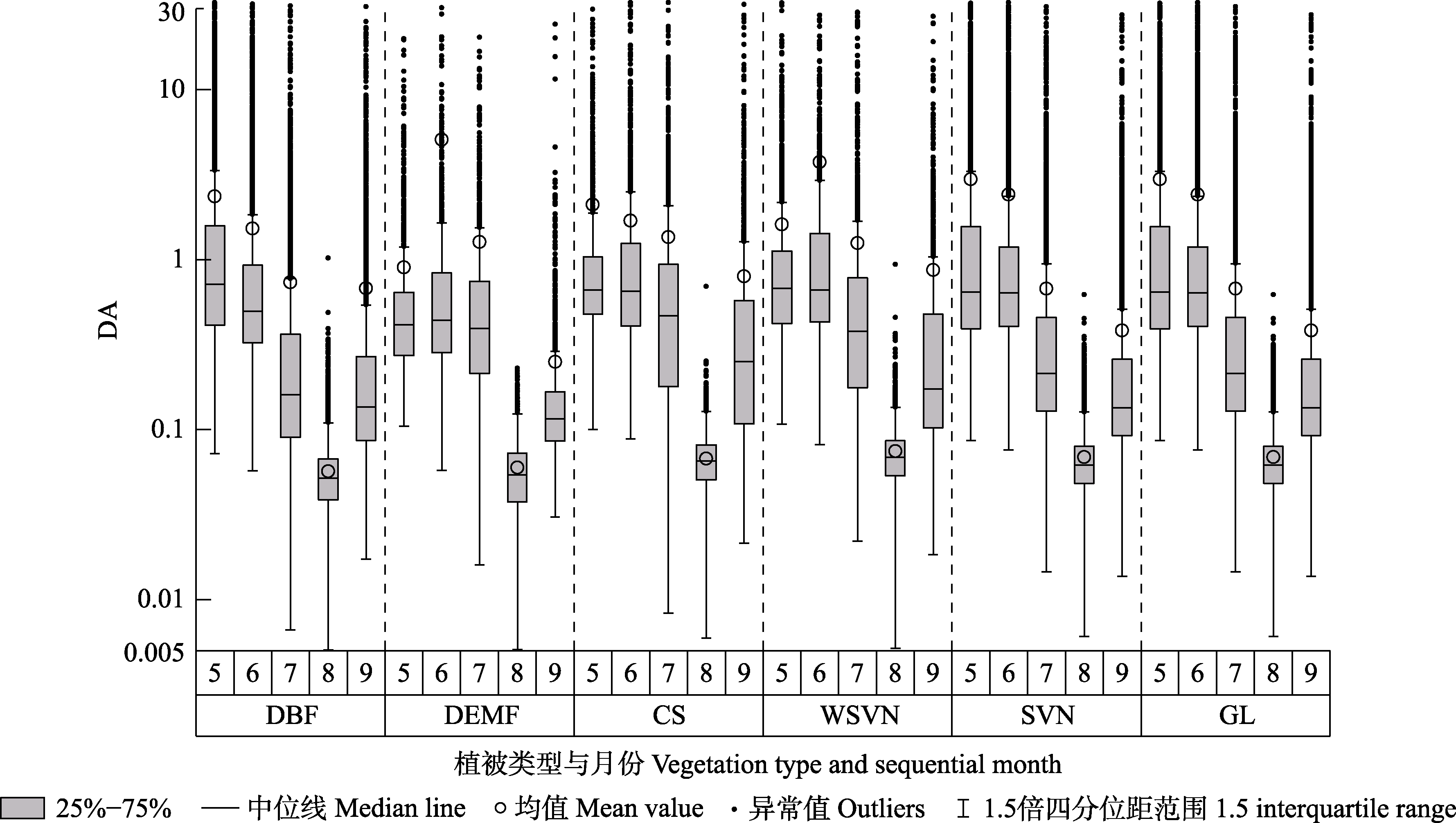
Fig. 9 Distribution of drought adaptability (DA) in the Hai River Basin, listed by vegetation type. CS, closed shrubland; DBF, deciduous broadleaf forest; DEMF, deciduous-evergreen mixed forest; GL, grassland; SVN, savanna; WSVN, woody savanna.
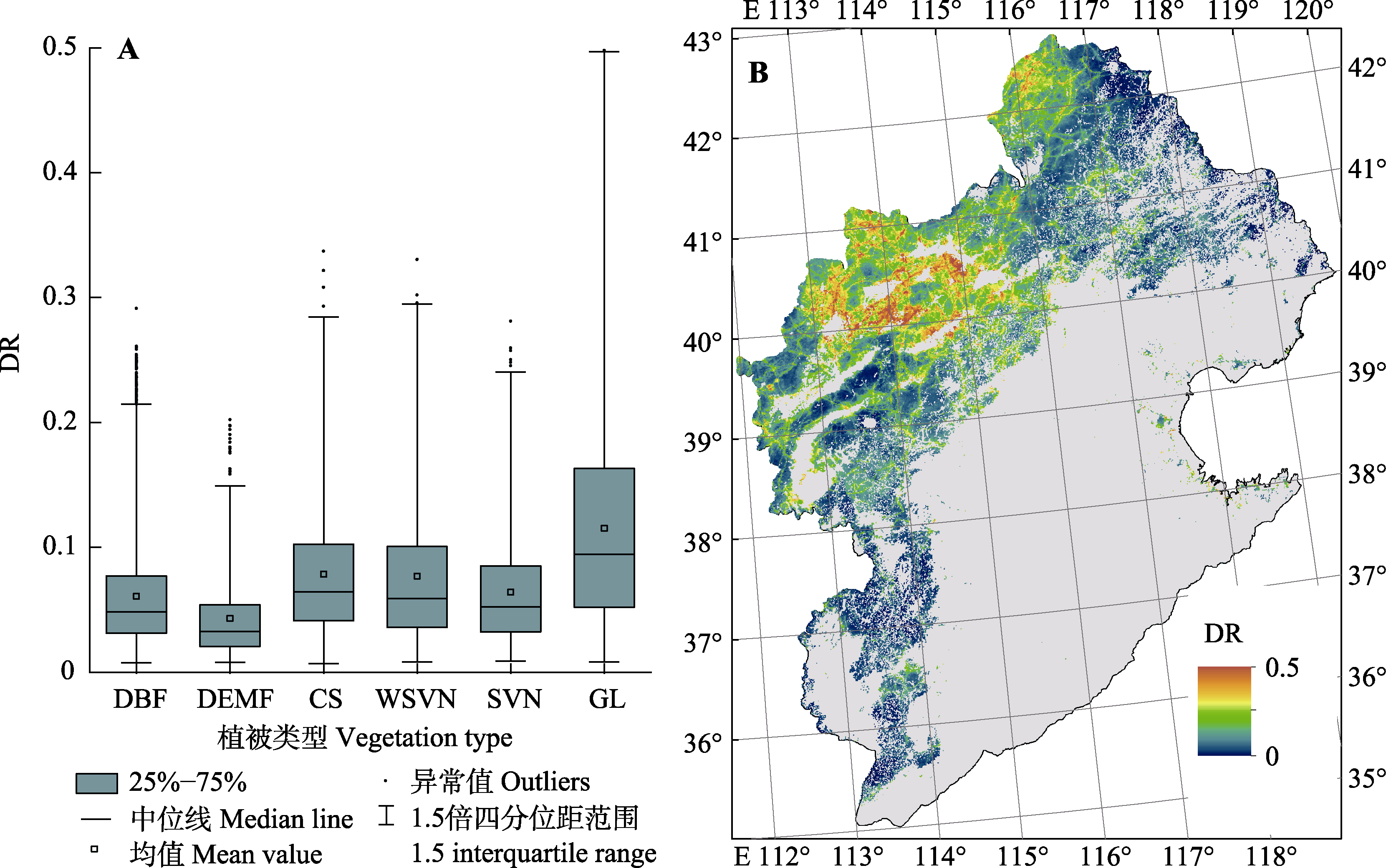
Fig. 10 Quantitative (A) and spatial (B) distribution of vegetation drought risk (DR) in the Hai River Basin. CS, closed shrubland; DBF, deciduous broadleaf forest; DEMF, deciduous-evergreen mixed forest; GL, grassland; SVN, savanna; WSVN, woody savanna.
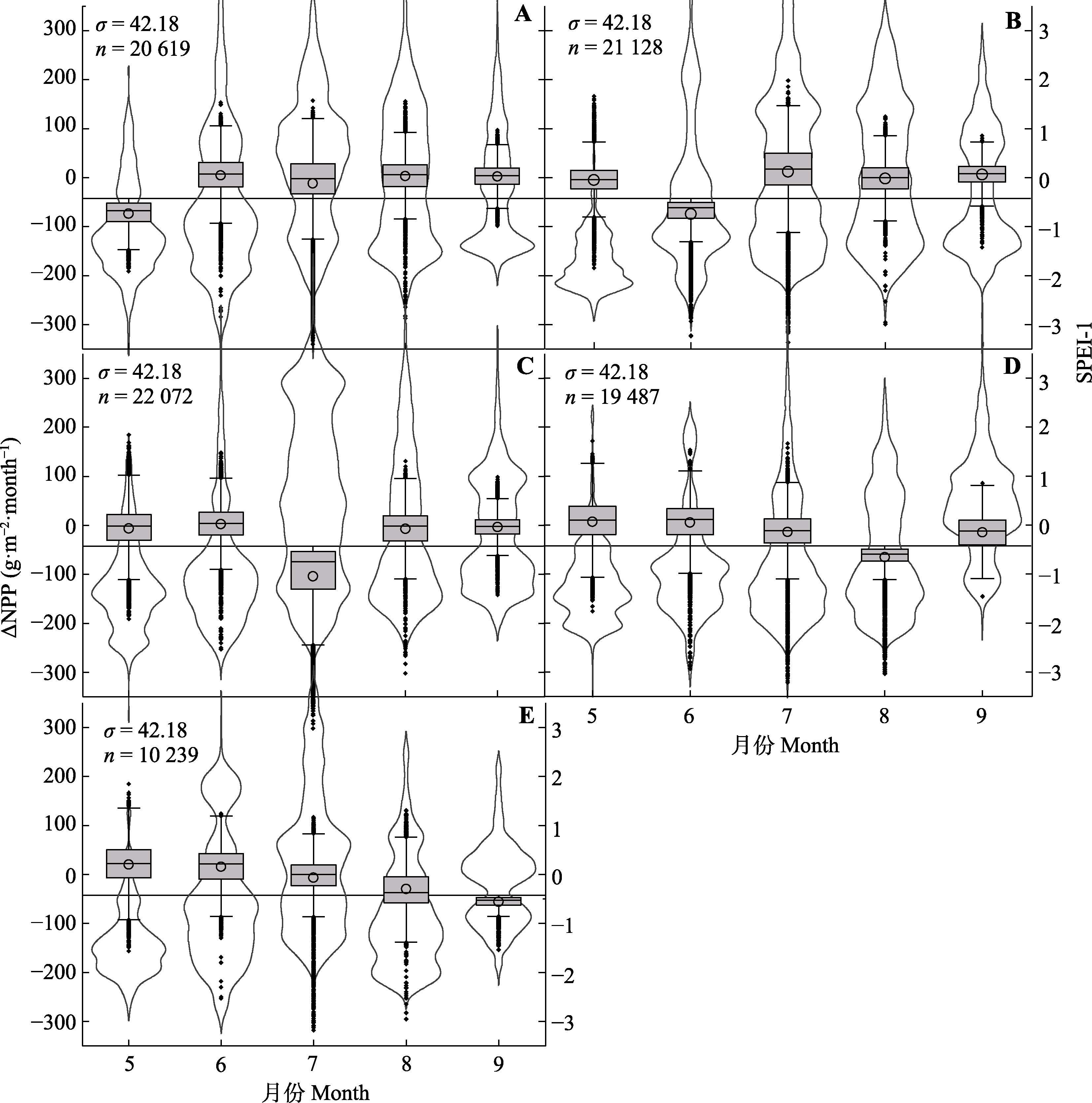
Fig. 11 Net primary productivity changes (∆NPP) boxplot and 1-month standardized precipitation evapotranspiration index (SPEI-1) violin plot of the whole growing season. The violin plot indicates probability density distribution of SPEI, in the boxplot, the box indicates 25%-75% distribution range, the middle line indicates the median value, the hollow circle indicates mean value, the whiskers indicate 1.5 interquartile range, the rhombuses indicate outliers. A-E correspond the situation in which NPP declined distinctly in May, June, …, September.

Fig. 13 Typical response pattern of vegetation net primary productivity changes (∆NPP) to 1-month standardized precipitation evapotranspiration index (SPEI-1) in the Hai River Basin. A-E present typical SPEI-1 and ∆NPP pattern of forest vegetation when NPP distinctly decrease in May to September, while F-J present typical SPEI-1 and ∆NPP pattern of shrub/grass vegetation when NPP distinctly decrease in May to September.
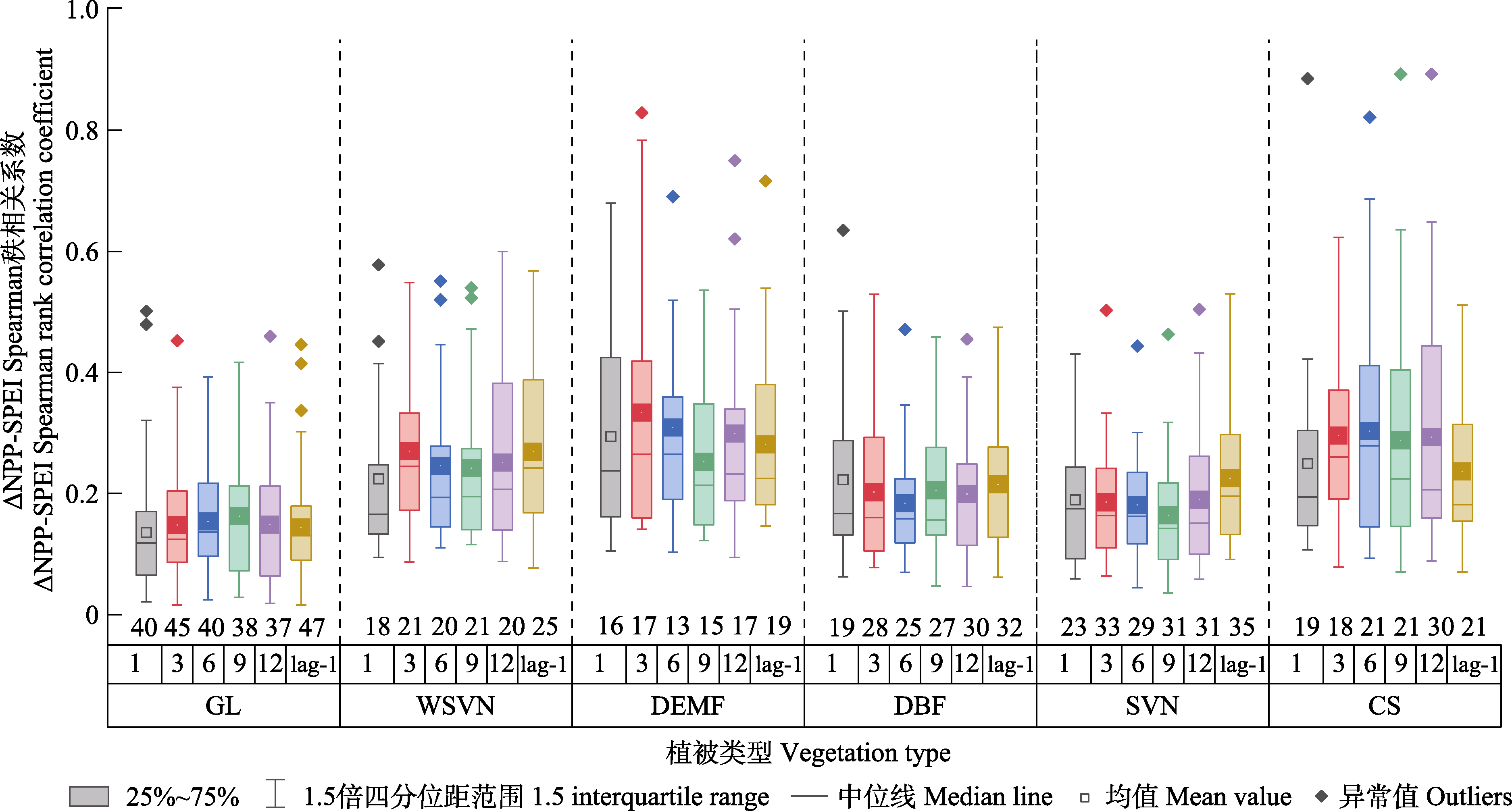
Fig. 15 Distribution of samples presenting significant positive correlation between net primary productivity changes (∆NPP) and standardized precipitation evapotranspiration index (SPEI) in the Hai River Basin. CS, closed shrubland; DBF, deciduous broadleaf forest; DEMF, deciduous-evergreen mixed forest; GL, grassland; SVN, savanna; WSVN, woody savanna. 1, 3, 6, 9, 12 and lag-1 under x axis are SPEI time scales, and the numbers above are the number of months in which the corresponding time scale SPEI is significantly positively correlated with ∆NPP.
| [1] | Allen CD, Macalady AK, Chenchouni H, Bachelet D, McDowell N, Vennetier M, Kitzberger T, Rigling A, Breshears DD, Hogg EH, Gonzalez P, Fensham R, Zhang Z, Castro J, Demidova N, et al. (2010). A global overview of drought and heat-induced tree mortality reveals emerging climate change risks for forests. Forest Ecology and Management, 259, 660-684. |
| [2] | Anderegg WRL, Konings AG, Trugman AT, Yu K, Bowling DR, Gabbitas R, Karp DS, Pacala S, Sperry JS, Sulman BN, Zenes N (2018). Hydraulic diversity of forests regulates ecosystem resilience during drought. Nature, 561, 538-541. |
| [3] | Anderegg WRL, Trugman AT, Badgley G, Konings AG, Shaw J (2020). Divergent forest sensitivity to repeated extreme droughts. Nature Climate Change, 10, 1091-1095. |
| [4] | Ayantobo OO, Li Y, Song S, Yao N (2017). Spatial comparability of drought characteristics and related return periods in mainland China over 1961-2013. Journal of Hydrology, 550, 549-567. |
| [5] | Constenla-Villoslada S, Liu Y, Wen J, Sun Y, Chonabayashi S (2022). Large-scale land restoration improved drought resilience in Ethiopiaʼs degraded watersheds. Nature Sustainability, 5, 488-497. |
| [6] | Crausbay SD, Ramirez AR, Carter SL, Cross MS, Hall KR, Bathke DJ, Betancourt JL, Colt S, Cravens AE, Dalton MS, Dunham JB, Hay LE, Hayes MJ, McEvoy J, McNutt CA, et al. (2017). Defining ecological drought for the twenty-first century. Bulletin of the American Meteorological Society, 98, 2543-2550. |
| [7] | Deng SS, Liu SX, Mo XG (2021a). Assessment and attribution of China’s droughts using an integrated drought index derived from GRACE and GRACE-FO data. Journal of Hydrology, 603, 127170. DOI: 10.1016/j.jhydrol.2021.127170. |
| [8] | Deng Y, Wang X, Wang K, Ciais P, Tang S, Jin L, Li L, Piao S (2021b). Responses of vegetation greenness and carbon cycle to extreme droughts in China. Agricultural and Forest Meteorology, 298-299, 108307. DOI: 10.1016/j.agrformet.2020.108307. |
| [9] | Doughty CE, Metcalfe DB, Girardin CAJ, Amezquita FF, Cabrera DG, Huasco WH, Silva-Espejo JE, Araujo-Murakami A, da Costa MC, Rocha W, Feldpausch TR, Mendoza ALM, da Costa ACL, Meir P, Phillips OL, Malhi Y (2015). Drought impact on forest carbon dynamics and fluxes in Amazonia. Nature, 519, 78-82. |
| [10] |
Field CB, Behrenfeld MJ, Randerson JT, Falkowski P (1998). Primary production of the biosphere: integrating terrestrial and oceanic components. Science, 281, 237-240.
DOI PMID |
| [11] | Field CB, Randerson JT, Malmström CM (1995). Global net primary production: combining ecology and remote sensing. Remote Sensing of Environment, 51, 74-88. |
| [12] | Gampe D, Zscheischler J, Reichstein M, OʼSullivan M, Smith WK, Sitch S, Buermann W (2021). Increasing impact of warm droughts on northern ecosystem productivity over recent decades. Nature Climate Change, 11, 772-779. |
| [13] | Gao Q, Zhao P, Zeng X, Cai X, Shen W (2002). A model of stomatal conductance to quantify the relationship between leaf transpiration, microclimate and soil water stress. Plant, Cell & Environment, 25, 1373-1381. |
| [14] |
He J, Yang K, Tang WJ, Lu H, Qin J, Chen YY, Li X (2020). The first high-resolution meteorological forcing dataset for land process studies over China. Scientific Data, 7, 25. DOI: 10.1038/s41597-020-0369-y.
PMID |
| [15] | Hu S, Mo XG, Lin ZH (2015). Projections of spatial-temporal variation of drought in North China. Arid Land Geography, 38, 239-248. |
| [ 胡实, 莫兴国, 林忠辉 (2015). 未来气候情景下我国北方地区干旱时空变化趋势. 干旱区地理, 38, 239-248.] | |
| [16] | IPCC (Intergovernmental Panel on Climate Change) (2007). Climate change 2007:impacts, adaptation and vulnerability// Working Group II Contribution to the IPCC Fourth Assessment Report of the IPCC. Cambridge University Press, Cambridge. |
| [17] | IPCC (Intergovernmental Panel on Climate Change) (2014). Climate change 2014: impacts, adaptation, and vulnerability: part B:regional aspects// Working Group II Contribution to the IPCC Fifth Assessment Report of the IPCC. Cambridge University Press, Cambridge. |
| [18] | IPCC (Intergovernmental Panel on Climate Change) (2021). Climate change 2021:the physical science basis// Working Group II Contribution to the IPCC Sixth Assessment Report of the IPCC. Cambridge University Press, Cambridge. |
| [19] | Jayanthi H, Husak GJ, Funk C, Magadzire T, Chavula A, Verdin JP (2013). Modeling rain-fed maize vulnerability to droughts using the standardized precipitation index from satellite estimated rainfall—Southern Malawi case study. International Journal of Disaster Risk Reduction, 4, 71-81. |
| [20] | Jiang B, Ouyang ZY, Miao H, Zheng H, Bai Y, Zhuang CW, Fang Y (2011). Ecosystem services valuation of the Haihe River Basin wetlands. Acta Ecologica Sinica, 31, 2236-2244. |
| [ 江波, 欧阳志云, 苗鸿, 郑华, 白杨, 庄长伟, 方瑜 (2011). 海河流域湿地生态系统服务功能价值评价. 生态学报, 31, 2236-2244.] | |
| [21] | Jiang DB, Wang XX (2021). A brief interpretation of drought change from IPCC Sixth Assessment Report. Transactions of Atmospheric Sciences, 44, 650-653. |
| [ 姜大膀, 王晓欣 (2021). 对IPCC第六次评估报告中有关干旱变化的解读. 大气科学学报, 44, 650-653.] | |
| [22] |
Jump AS, Ruiz-Benito P, Greenwood S, Allen CD, Kitzberger T, Fensham R, Martínez-Vilalta J, Lloret F (2017). Structural overshoot of tree growth with climate variability and the global spectrum of drought-induced forest dieback. Global Change Biology, 23, 3742-3757.
DOI PMID |
| [23] | Keyantash J, Dracup JA (2002). The quantification of drought: an evaluation of drought indices. Bulletin of the American Meteorological Society, 83, 1167-1180. |
| [24] | Khoury S, Coomes DA (2020). Resilience of Spanish forests to recent droughts and climate change. Global Change Biology, 26, 7079-7098. |
| [25] | Li KW, Tong ZJ, Liu XP, Zhang JQ, Tong SQ (2020a). Quantitative assessment and driving force analysis of vegetation drought risk to climate change: methodology and application in Northeast China. Agricultural and Forest Meteorology, 282-283, 107865. DOI: 10.1016/j.agrformet.2019.107865. |
| [26] | Li X, Piao S, Wang K, Wang X, Wang T, Ciais P, Chen AP, Lian X, Peng S, Peñuelas J (2020b). Temporal trade-off between gymnosperm resistance and resilience increases forest sensitivity to extreme drought. Nature Ecology & Evolution, 4, 1075-1083. |
| [27] | Liu D, Wang T, Peñuelas J, Piao S (2022). Drought resistance enhanced by tree species diversity in global forests. Nature Geoscience, 15, 800-804. |
| [28] | Los SO, Justice CO, Tucker CJ (1994). A global 1° by 1° NDVI data set for climate studies derived from the GIMMS continental NDVI data. International Journal of Remote Sensing, 15, 3493-3518. |
| [29] | Lv Y, He HL, Ren XL, Zhang L, Qin KY, Wu XJ, Niu ZE, Feng LL, Xu Q, Zhang MY (2022). High resistance of deciduous forests and high recovery rate of evergreen forests under moderate droughts in China. Ecological Indicators, 144, 109469. DOI: 10.1016/j.ecolind.2022.109469. |
| [30] | Mishra AK, Singh VP (2010). A review of drought concepts. Journal of Hydrology, 391, 202-216. |
| [31] | Mo XG, Lin ZH, Liu SX (2000). An improvement of the dual-source model based on Penman-Monteith formula. Journal of Hydraulic Engineering, 31(5), 6-11. |
| [ 莫兴国, 林忠辉, 刘苏峡 (2000). 基于Penman-Monteith公式的双源模型的改进. 水利学报, 31(5), 6-11.] | |
| [32] |
Mo XG, Liu SX, Hu S (2022). Co-evolution of climate-vegetation-hydrology and its mechanisms in the source region of Yellow River. Acta Geographica Sinica, 77, 1730-1744.
DOI |
|
[ 莫兴国, 刘苏峡, 胡实 (2022). 黄河源区气候-植被-水文协同演变及成因辨析. 地理学报, 77, 1730-1744.]
DOI |
|
| [33] | Mo XG, Liu SX, Lin ZH, Zhao WM (2004). Simulating temporal and spatial variation of evapotranspiration over the Lushi basin. Journal of Hydrology, 285, 125-142. |
| [34] |
Mo XG, Xue L, Lin ZH (2005). Spatio-temporal distribution of crop evapotranspiration from 1981-2001 over the North China Plain. Journal of Natural Resources, 20, 181-187.
DOI |
| [ 莫兴国, 薛玲, 林忠辉 (2005). 华北平原1981-2001年作物蒸散量的时空分异特征. 自然资源学报, 20, 181-187.] | |
| [35] | Potter C, Randerson J, Field C, Matson P, Vitousek P, Mooney H, Klooster S (1993). Terrestrial ecosystem production: a process model based on global satellite and surface data. Global Biogeochemical Cycles, 7, 811-841. |
| [36] | Ruimy A, Saugier B, Dedieu G (1994). Methodology for the estimation of terrestrial net primary production from remotely sensed data. Journal of Geophysical Research: Atmospheres, 99, 5263-5283. |
| [37] | Sharma A, Goyal MK (2018). Assessment of ecosystem resilience to hydroclimatic disturbances in India. Global Change Biology, 24, e432-e441. |
| [38] | Singh VP, Guo H, Yu FX (1993). Parameter estimation for 3-parameter log-logistic distribution (LLD3) by Pome. Stochastic Hydrology and Hydraulics, 7, 163-177. |
| [39] | Smith T, Traxl D, Boers N (2022). Empirical evidence for recent global shifts in vegetation resilience. Nature Climate Change, 12, 477-484. |
| [40] | Song LS, Li Y, Ren YH, Wu XC, Guo B, Tang XG, Shi WY, Ma MG, Han XJ, Zhao L (2019). Divergent vegetation responses to extreme spring and summer droughts in Southwestern China. Agricultural and Forest Meteorology, 279, 107703. DOI: 10.1016/j.agrformet.2019.107703. |
| [41] | Towfiqul Islam ARM, Shen S, Hu Z, Atiqu Rahman M (2017). Drought hazard evaluation in boro paddy cultivated areas of western Bangladesh at current and future climate change conditions. Advances in Meteorology, 2017, 3514381. DOI: 10.1155/2017/3514381. |
| [42] | Vicente-Serrano SM, Beguería S, López-Moreno JI (2010). A multiscalar drought index sensitive to global warming: the standardized precipitation evapotranspiration index. Journal of Climate, 23, 1696-1718. |
| [43] | Wang Y, Zhang CS, Liu CL, Zhen L (2019). Research on the pattern and change of forest water conservation in Three-North Shelterbelt Forest Program region, China. Acta Ecologica Sinica, 39, 5847-5856. |
| [ 王耀, 张昌顺, 刘春兰, 甄霖 (2019). 三北防护林体系建设工程区森林水源涵养格局变化研究. 生态学报, 39, 5847-5856.] | |
| [44] | Wang YF, Mo XG, Hao YB, Guo RP, Huang XZ, Wang YF (2008). Simulating seasonal and interannual variations of ecosystem evapotranspiration and its components in Inner Mongolia steppe with VIP model. Journal of Plant Ecology (Chinese Version), 32, 1052-1060. |
|
[ 王永芬, 莫兴国, 郝彦宾, 郭瑞萍, 黄祥忠, 王艳芬 (2008). 基于VIP模型对内蒙古草原蒸散季节和年际变化的模拟. 植物生态学报, 32, 1052-1060.]
DOI |
|
| [45] | Wang YL, Ding Y, Hu Y, Chen J, Fan WW (2019). The study of shrubland drought dynamics in China and its impacts on vegetation growth. Acta Ecologica Sinica, 39, 2054-2062. |
| [ 王亚林, 丁忆, 胡艳, 陈静, 范文武 (2019). 中国灌木生态系统的干旱化趋势及其对植被生长的影响. 生态学报, 39, 2054-2062.] | |
| [46] | Wang ZL, Li J, Lai CG, Zeng ZY, Zhong RD, Chen XH, Zhou XW, Wang MY (2017). Does drought in China show a significant decreasing trend from 1961 to 2009? Science of the Total Environment, 579, 314-324. |
| [47] | Wu Y, Zeng Y, Zhao Y, Wu BF, Wu WB (2010). Monitoring and dynamic analysis of fractional vegetation cover in the Hai River Basin based on MODIS data. Resources Science, 32, 1417-1424. |
| [ 吴云, 曾源, 赵炎, 吴炳方, 武文波 (2010). 基于MODIS数据的海河流域植被覆盖度估算及动态变化分析. 资源科学, 32, 1417-1424.] | |
| [48] | Xie SD, Mo XG, Hu S, Liu SX (2020). Contributions of climate change, elevated atmospheric CO2 and human activities to ET and GPP trends in the Three-North Region of China. Agricultural and Forest Meteorology, 295, 108183. DOI: 10.1016/j.agrformet.2020.108183. |
| [49] | Xu HJ, Wang XP, Zhao CY, Yang XM (2018). Diverse responses of vegetation growth to meteorological drought across climate zones and land biomes in northern China from 1981 to 2014. Agricultural and Forest Meteorology, 262, 1-13. |
| [50] | Yan DH, Wu D, Huang R, Wang LN, Yang GY (2013). Drought evolution characteristics and precipitation intensity changes during alternating dry-wet changes in the Huang-Huai-Hai River basin. Hydrology and Earth System Sciences, 17, 2859-2871. |
| [51] | Yao TT, Liu SX, Hu S, Mo XG (2022). Response of vegetation ecosystems to flash drought with solar-induced chlorophyll fluorescence over the Hai River Basin, China during 2001-2019. Journal of Environmental Management, 313, 114947. DOI: 10.1016/j.jenvman.2022.114947. |
| [52] | Zhang L, Chu QQ, Jiang YL, Chen F, Lei YD (2021a). Impacts of climate change on drought risk of winter wheat in the North China Plain. Journal of Integrative Agriculture, 20, 2601-2612. |
| [53] | Zhang Q, Zhang JQ, Wang CY (2017). Risk assessment of drought disaster in typical area of corn cultivation in China. Theoretical and Applied Climatology, 128, 533-540. |
| [54] | Zhang Y, Keenan TF, Zhou S (2021b). Exacerbated drought impacts on global ecosystems due to structural overshoot. Nature Ecology & Evolution, 5, 1490-1498. |
| [55] | Zhang YC, Jiang HB, Zhang CW, Shen YJ (2020). Daily fluxes dataset of the typical irrigated agro-ecosystem in the North China Plain: a case study of Luancheng Station (2007-2013). China Scientific Data, 5(2), 36-46. |
| [ 张玉翠, 姜寒冰, 张传伟, 沈彦俊 (2020). 2007-2013年华北平原典型灌溉农田生态系统日通量数据集——以栾城站为例. 中国科学数据, 5(2), 36-46.] | |
| [56] | Zhao AZ, Zhang AB, Cao S, Liu XF, Liu JH, Cheng DY (2018). Responses of vegetation productivity to multi-scale drought in Loess Plateau, China. Catena, 163, 165-171. |
| [57] | Zhu WQ, Pan YZ, Zhang JS (2007). Estimation of net primary productivity of Chinese terrestrial vegetation based on remote sensing. Journal of Plant Ecology (Chinese Version), 31, 413-424. |
|
[ 朱文泉, 潘耀忠, 张锦水 (2007). 中国陆地植被净初级生产力遥感估算. 植物生态学报, 31, 413-424.]
DOI |
| [1] | ZHU Yu-Ying, ZHANG Hua-Min, DING Ming-Jun, YU Zi-Ping. Changes of vegetation greenness and its response to drought-wet variation on the Qingzang Plateau [J]. Chin J Plant Ecol, 2023, 47(1): 51-64. |
| [2] | ZHANG Yi, CHENG Jie, SU Ji-Shuai, CHENG Ji-Min. Diversity-productivity relationship of plant communities in typical grassland during the long- term grazing exclusion succession [J]. Chin J Plant Ecol, 2022, 46(2): 176-187. |
| [3] | ZANG Yong-Xin, MA Jian-Ying, ZHOU Xiao-Bing, TAO Ye, YIN Ben-Feng, Shayaguli JIGEER, ZHANG Yuan-Ming. Effects of extreme drought and extreme precipitation on aboveground productivity of ephemeral plants across different slope positions along sand dunes [J]. Chin J Plant Ecol, 2022, 46(12): 1537-1550. |
| [4] | JI Yu-He, ZHOU Guang-Sheng, WANG Shu-Dong, WANG Li-Xia, ZHOU Meng-Zi. Evolution characteristics and its driving forces analysis of vegetation ecological quality in Qinling Mountains region from 2000 to 2019 [J]. Chin J Plant Ecol, 2021, 45(6): 617-625. |
| [5] | FANG Ou-Ya, ZHANG Yong, ZHANG Qi, JIA Heng-Feng. Growth responses of Tamarix austromongolica to extreme drought and flood in the upper Yellow River basin [J]. Chin J Plant Ecol, 2021, 45(6): 641-649. |
| [6] | WANG Yi-Dan, LI Liang, LIU Qi-Jing, MA Ze-Qing. Lifespan and morphological traits of absorptive fine roots across six typical tree species in subtropical China [J]. Chin J Plant Ecol, 2021, 45(4): 383-393. |
| [7] | LI Zhou-Yuan, YE Xiao-Zhou, WANG Shao-Peng. Ecosystem stability and its relationship with biodiversity [J]. Chin J Plant Ecol, 2021, 45(10): 1127-1139. |
| [8] | GAMADAERJI , YANG Ze, TAN Xing-Ru, WANG Shan-Shan, LI Wei-Jing, YOU Cui-Hai, WANG Yan-Bing, ZHANG Bing-Wei, REN Ting-Ting, CHEN Shi-Ping. Effect of altered litter input and nitrogen addition on ecosystem aboveground primary productivity and plant functional group composition in a semiarid grassland [J]. Chin J Plant Ecol, 2020, 44(8): 791-806. |
| [9] | SHU Shu-Miao, ZHU Wan-Ze, RAN Fei, SUN Shou-Qin, ZHANG Yuan-Yuan. Season dynamics of carbon use efficiency and its influencing factors in the old-growth Abies fabri forest in Gongga Mountain, western Sichuan, China [J]. Chin J Plant Ecol, 2020, 44(11): 1127-1137. |
| [10] | WANG Yu-Bing,SUN Yi-Han,DING Wei,ZHANG En-Tao,LI Wen-Huai,CHI Yong-Gang,ZHENG Shu-Xia. Effects and pathways of long-term nitrogen addition on plant diversity and primary productivity in a typical steppe [J]. Chin J Plant Ecol, 2020, 44(1): 22-32. |
| [11] | LI Jian-Jun, LIU Lian, CHEN Di-Ma, XU Feng-Wei, CHENG Jun-Hui, BAI Yong-Fei. Effects of collar size and buried depth on the measurement of soil respiration in a typical steppe [J]. Chin J Plant Ecol, 2019, 43(2): 152-164. |
| [12] | WU Hong-Bao, GAO Qing-Zhu, Ganjurjav Hasbagan, LI Yu, YAN Yu-Long, HU Guo-Zheng, WANG Xue-Xia, YAN Jun, HE Shi-Cheng. Effects of grazing and simulated warming on plant community structure and productivity of alpine grassland in Northern Xizang, China [J]. Chin J Plant Ecol, 2019, 43(10): 853-862. |
| [13] | Ya-Lin XIE, Hai-Yan WANG, Xiang-Dong LEI. Effects of climate change on net primary productivity in Larix olgensis plantations based on process modeling [J]. Chin J Plan Ecolo, 2017, 41(8): 826-839. |
| [14] | Deng-Qiu LI, Chun-Hua ZHANG, Wei-Min JU, Li-Juan LIU. Forest net primary productivity dynamics and driving forces in Jiangxi Province, China [J]. Chin J Plant Ecol, 2016, 40(7): 643-657. |
| [15] | PAN Shi-Yu,KONG Bin-Bin,YAO Tian-Hua,WEI Xin-Hua,LI Ying-Nian,ZHU Zhi-Hong. Effects of clipping and fertilizing on the relationship between functional diversity and aboveground net primary productivity in an alpine meadow [J]. Chin J Plan Ecolo, 2015, 39(9): 867-877. |
| Viewed | ||||||
|
Full text |
|
|||||
|
Abstract |
|
|||||
Copyright © 2022 Chinese Journal of Plant Ecology
Tel: 010-62836134, 62836138, E-mail: apes@ibcas.ac.cn, cjpe@ibcas.ac.cn